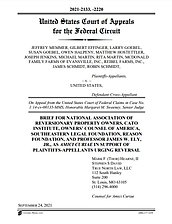Railroad lines once extended throughout the United States. At its peak in 1916, more than 270,000 miles of track crisscrossed the country. As railroads became less popular, thousands of miles of rail lines were left unused. Since the 1980s, the Rails‐to‐Trails Act has converted former rail lines into hiking and biking trails. Many of those rail lines were originally easements across private property. Under common‐law doctrine, when an easement is abandoned and no longer used for the original purpose, the land reverts to the property over which the easement was granted. Therefore, if the government wants to use part of an abandoned rail line for a trail, it needs to pay for the land under the Takings Clause of the Fifth Amendment.
The previous owners of the plaintiffs’ land conveyed an easement over for the operation of a rail line. In 2010, the federal Surface Transportation Board granted Indiana Southwestern Railway Company’s petition to abandon the stretch of rail running across the current owners’ land. After granting the request, the Board invoked the Rails‐to‐Trails Act, with plans to use the easement for a public recreation trail. The Memmers and other property owners challenged the change as a taking of their property and were thus owed compensation. The Court of Federal Claims disagreed, and the plaintiffs have appealed.
Cato has joined the National Association of Reversionary Property Owners, Owners’ Counsel of America, Southeastern Legal Foundation, Reason Foundation, and renowned property law professor James W. Ely, Jr. in an amicus brief urging the appellate court to reverse the lower court ruling. We argue that under state‐law principles—which even in the federal eminent domain context govern the disposition of property interests—an easement, once abandoned, reverts to the landowners and re‐merges into their property.
The Rails‐to‐Trails Act does not give the federal government carte blanche to convert railroad right‐of‐way easements into recreational trails or other public uses. When the federal government invokes the act to repackage abandoned rail lines, it must do so in a manner that respects existing state property laws. Here, the plaintiffs simply seek just compensation for a new use unauthorized and not contemplated under the original easement. The Federal Circuit should affirm the lower court or countless property owners will be subject to a rails‐to‐trails program that has, well, gone off the rails.





